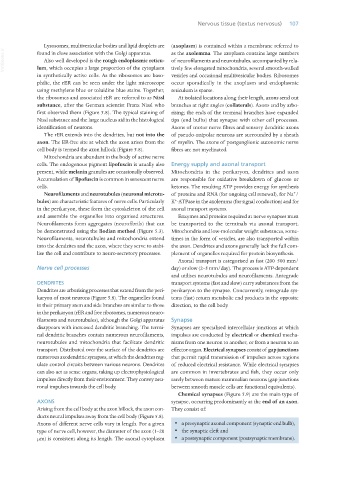Page 125 - Veterinary Histology of Domestic Mammals and Birds, 5th Edition
P. 125
Nervous tissue (textus nervosus) 107
Lysosomes, multivesicular bodies and lipid droplets are (axoplasm) is contained within a membrane referred to
VetBooks.ir found in close association with the Golgi apparatus. as the axolemma. The axoplasm contains large numbers
Also well developed is the rough endoplasmic reticu-
of neurofilaments and neurotubules, accompanied by rela-
lum, which occupies a large proportion of the cytoplasm tively few elongated mitochondria, several smooth-walled
in synthetically active cells. As the ribosomes are baso- vesicles and occasional multivesicular bodies. Ribosomes
philic, the rER can be seen under the light microscope occur sporadically in the axoplasm and endoplasmic
using methylene blue or toluidine blue stains. Together, reticulum is sparse.
the ribosomes and associated rER are referred to as Nissl At isolated locations along their length, axons send out
substance, after the German scientist Franz Nissl who branches at right angles (collaterals). Axons end by arbo-
first observed them (Figure 5.8). The typical staining of rising; the ends of the terminal branches have expanded
Nissl substance and the large nucleus aid in the histological tips (end bulbs) that synapse with other cell processes.
identification of neurons. Axons of motor nerve fibres and sensory dendritic axons
The rER extends into the dendrites, but not into the of pseudo-unipolar neurons are surrounded by a sheath
axon. The ER-free site at which the axon arises from the of myelin. The axons of postganglionic autonomic nerve
cell body is termed the axon hillock (Figure 5.8). fibres are not myelinated.
Mitochondria are abundant in the body of active nerve
cells. The endogenous pigment lipofuscin is usually also Energy supply and axonal transport
present, while melanin granules are occasionally observed. Mitochondria in the perikaryon, dendrites and axon
Accumulation of lipofuscin is common in senescent nerve are responsible for oxidative breakdown of glucose or
cells. ketones. The resulting ATP provides energy for synthesis
+
Neurofilaments and neurotubules (neuronal microtu- of proteins and RNA (for ongoing cell renewal), for Na /
bules) are characteristic features of nerve cells. Particularly K -ATPase in the axolemma (for signal conduction) and for
+
in the perikaryon, these form the cytoskeleton of the cell axonal transport systems.
and assemble the organelles into organised structures. Enzymes and proteins required at nerve synapses must
Neurofilaments form aggregates (neurofibrils) that can be transported to the terminals via axonal transport.
be demonstrated using the Bodian method (Figure 5.3). Mitochondria and low-molecular weight substances, some-
Neurofilaments, neurotubules and mitochondria extend times in the form of vesicles, are also transported within
into the dendrites and the axon, where they serve to stabi- the axon. Dendrites and axons generally lack the full com-
lise the cell and contribute to neuro-secretory processes. plement of organelles required for protein biosynthesis.
Axonal transport is categorised as fast (200–500 mm/
Nerve cell processes day) or slow (2–5 mm/day). The process is ATP-dependent
and utilises neurotubules and neurofilaments. Antegrade
DENDRITES transport systems (fast and slow) carry substances from the
Dendrites are arborising processes that extend from the peri- perikaryon to the synapse. Concurrently, retrograde sys-
karyon of most neurons (Figure 5.8). The organelles found tems (fast) return metabolic end products in the opposite
in their primary stem and side branches are similar to those direction, to the cell body.
in the perikaryon (rER and free ribosomes, numerous neuro-
filaments and neurotubules), although the Golgi apparatus Synapse
disappears with increased dendritic branching. The termi- Synapses are specialised intercellular junctions at which
nal dendritic branches contain numerous neurofilaments, impulses are conducted by electrical or chemical mecha-
neurotubules and mitochondria that facilitate dendritic nisms from one neuron to another, or from a neuron to an
transport. Distributed over the surface of the dendrites are effector organ. Electrical synapses consist of gap junctions
numerous axodendritic synapses, at which the dendrites reg- that permit rapid transmission of impulses across regions
ulate control circuits between various neurons. Dendrites of reduced electrical resistance. While electrical synapses
can also act as sense organs, taking up electrophysiological are common in invertebrates and fish, they occur only
impulses directly from their environment. They convey neu- rarely between mature mammalian neurons (gap junctions
ronal impulses towards the cell body. between smooth muscle cells are functional equivalents).
Chemical synapses (Figure 5.9) are the main type of
AXONS synapse, occurring predominantly at the end of an axon.
Arising from the cell body at the axon hillock, the axon con- They consist of:
ducts neural impulses away from the cell body (Figure 5.8).
Axons of different nerve cells vary in length. For a given · a presynaptic axonal component (synaptic end bulb),
type of nerve cell, however, the diameter of the axon (1–20 · the synaptic cleft and
μm) is consistent along its length. The axonal cytoplasm · a postsynaptic component (postsynaptic membrane).
Vet Histology.indb 107 16/07/2019 14:57

